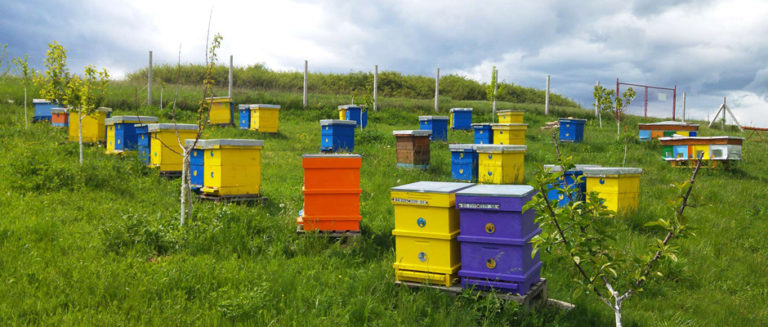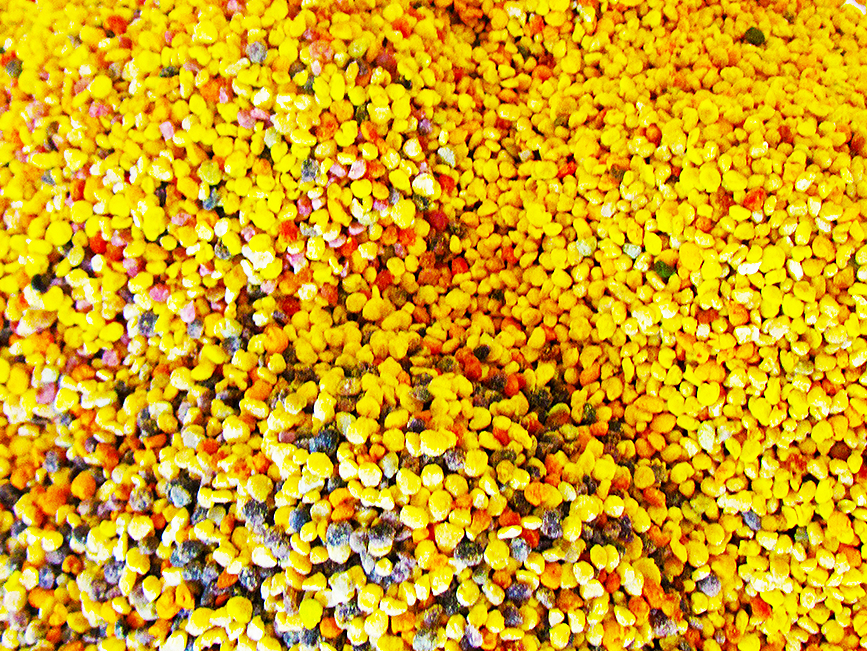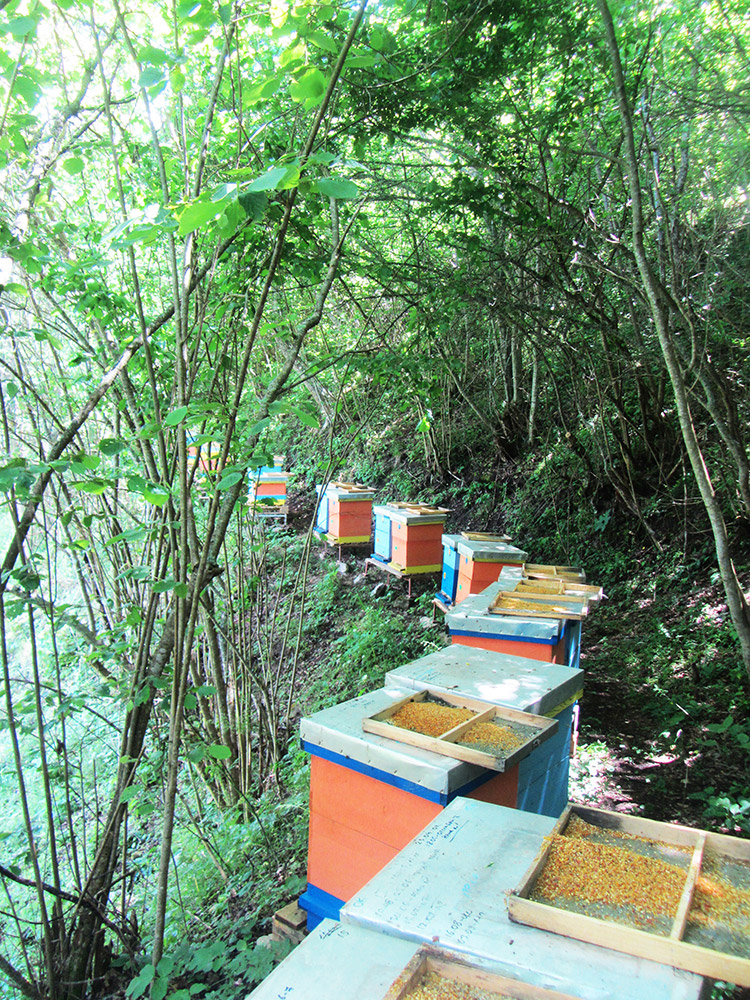
WHAT IS BEE POLLEN AND 10 WAYS TO CONSUME
Bee pollen is known as a food of high nutritional value and sometimes even occurs under the name of “super food”. An interesting fact is that the protein content in a spoon-two bee pollen equals the quantity in pork steak. Pollen is sweet, delicious and easy to eat, so consumption easily becomes a habit. Energy after consumption is felt most clearly after a week or two. The lack of energy is noticeable when you miss your intake for a day or two. By taking pollen, it is possible to reduce food consumption because it is nutritious and suppresses appetite.
It should not be overtaken with large amounts of pollen because there is, albeit negligible, a risk of allergic reaction. For this you should always start with small amounts of pollen daily and slowly increase to the recommended daily dose

What is bee pollen?
The honeybee gathers thousands of pollen beads from the flowering of flowers, shrubs and trees. Polena sticks to their mossy bodies, from where they bury it with their hind legs and, with the help of nectar, form small granules of pollen. These granules are delivered to the hive, at the entrance of which are placed so-called polluters. Pollens are small holes through which bees swarm and “drop” some of the pollen they carry. However, bees are able to deliver more than the required amount of pollen inside the hive. Pollen harvesting is absolutely harmless to bees because the beekeeper takes only part of the surplus delivered by the bees.
Why use bee pollen?
Bee pollen is good for boosting your immune system, increasing energy levels, delaying the aging process, treating infertility problems and preventing colds and flu, and many others. Bee pollen is also used as a remedy to treat allergies.
How to adopt bee pollen?
If you wish to take bee pollen for health reasons or in the hope of reducing the effect of seasonal allergies, you should be cautious. Even if you have not had an allergic reaction to pollen or bee products, you should start consuming bee pollen slowly and in small amounts. If you have an allergy to bee products, do not try. Whenever you begin to consume something new, be careful and do not overdo it.
Adults can start taking one ¼ teaspoon once, increasing each day to a full teaspoon. The maximum amount for adults should not exceed 2 tablespoons per day.
Children should start with a few granules, then the intake increases but should not exceed ½ teaspoon a day.
Every 2-3 months, a 1-month rest period is required.
Is there poor bee pollen?
It is important that bee pollen be harvested in the cleanest possible environment. While with honey, environmental cleanliness is not particularly important because bees filter nectars and finished honey is absolutely clean from dirt, in pollen things are not that way. It is important that within 5 km of bees there is no industrial production, laden roads, active farming or other types of pollutants. Avoid pollen harvested in urban or pollen from monocultures that have been treated with pesticides.
Are there different types of bee pollen?
Yes, bee pollen is divided into two types – monoflorous and polyflorin.
Monoflorous pollen is derived from a kind of flowering plant. This usually happens when a plant blooms a lot, and the other flowers are insignificant. Most commonly such pollen can be harvested early in the spring when the dandelion blooms, during the flowering of the amorphus, views and more. There is also pollen of monocultures such as rape and sunflower.
Polypolar (pollen) pollen contains pollen from dozens and sometimes hundreds of flowering plants. This pollen is most commonly harvested at the end of spring and all summer. Polyfloreal pollen is most valuable as a food in terms of containing a larger range of active substances.

resh or dried bee pollen and what is the difference?
Spring and summer, when there is fresh pollen, is preferable. In the rest of the year in the absence of fresh is consumed dried pollen.
The fresh pollen is in the state it was harvested from the hive. This allows you to take advantage of the whole range of active ingredients. Fresh pollen has high humidity and is soft to the touch, it is greasy when rubbed, it is easy to consume. Its taste is fruity (apple taste), colorful, you feel the aroma of flowers but with your taste buds, and it is also sweet. The fragrance is strong, sometimes stronger than a freshly picked bouquet of forest meadow.
The only treatment of fresh pollen is sifting and milking.
Once you get fresh pollen, you must place it in the refrigerator or freezer compartment to freeze. This ensures that if there are any microorganisms in the pollen during collection until it is packed, they will be destroyed.
Store frozen, consuming only with the required amount. Frozen fresh pollen is easily thawed for about a minute and ready for consumption.
Dried pollen is passed through sieving, blowing and drying at a specific temperature. In this process, 30-40% of the active substances are lost. However, dried pollen has a wide range of vitamins, proteins, proteins, fiber, iron, magnesium, zinc, vitamin C, vitamin B1, vitamin B2, vitamin B3 and many others. The taste of dried pollen resembles the scent of flowering meadows. Granules are crunchy and need to chew well before ingestion. Store in its original packaging in a dark and cool place.
If you’re wondering what pollen to choose, you can do it according to the season. Bee pollen is harvested during the months of April – August, and this is the time when fresh pollen is preferable. Fresh pollen may remain frozen for 4 to 6 months after harvest, but because of its high humidity and other factors, it has a rapid disintegration of active substances. It is best to consume it as soon as possible after it has been harvested.
From September to March, it is preferable to consume dried pollen. As it is dried, its humidity is reduced and stored properly and the remaining active ingredients are kept longer than unsatisfied.
10 ways to consume bee pollen
- Put some fresh pollen under the tongue until it dissolves and then swallow with a glass of water.
- Dissolve pollen in water, milk or other non-liquid liquid from the evening and drink it in the morning before eating.
- Add about 20g. pollen to 100g. copper. Stir until the pollen dissolves completely. Eat a spoonful of two on a hungry stomach every day.
- Sprinkle ground bee pollen on yogurt or cereal with fresh milk.
- Add bee pollen to your troubles.
- Sprinkle fresh pollen into granules or ground powdered pollen on the salad.
- Add ground bee pollen to copper or honey mustard dressing.
- Sprink ground bee pollen on a Garash cake or black chocolate cake.
- Use ground pollen as a sprinkling on candied almonds or hazelnuts.
- Stir bread, smear honey and sprinkle fresh or ground dried pollen.
